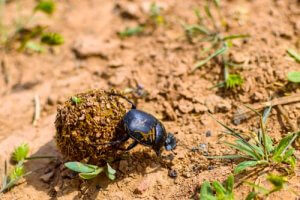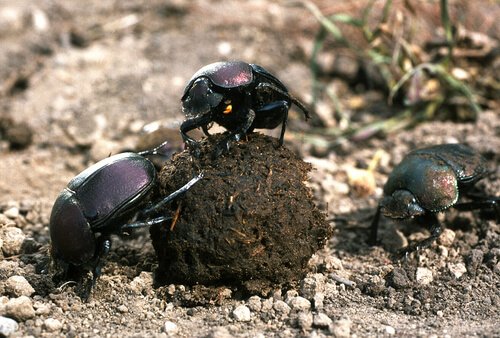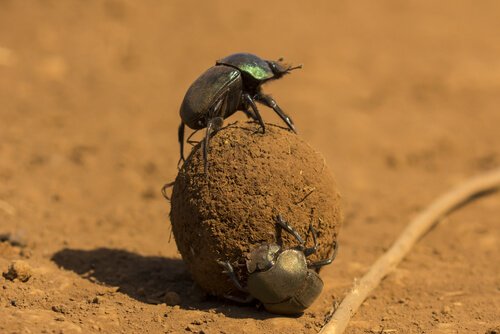Manure Kings: The Strange Dung Beetle


Written and verified by the biotechnologist Alejandro Rodríguez
The creature we’ll be talking about today is widely known around the world as the dung beetle. Apart from its name, there are many other facts about this insect that we’ll reveal to you in this article. Keep reading to find out all its secrets!
What is a dung beetle?
The term “dung beetle” refers to a very particular group of insects. They fall within the Coleoptera order, which brings together some 375,000 different species. The best-known Coleoptera with this name belong to the genus Scarabeus (among others), with S. viettei and S. laticollis as its two main representatives.
Morphologically, we’re talking about insects that are of medium size with strong legs. The dung beetle uses these legs both for walking and digging, but also for shaping balls of manure.
Usually their bodies have an intense metallic black color, although they can also have tones of blue, green and even yellow.
It’s evident that the most characteristic feature of this Coleoptera is its coprophagous behavior: this means that it feeds on excrement. But that is not the only use they have for dung.
What do they use other animals’ feces for?
As soon as they detect the presence of excrement, these animals fly to it in large swarms. By bringing several pieces together, they can reduce a large pile of dung produced by a large animal (like an elephant) to a carpet of undigested fibrous material.

At this point, the dung beetle breaks off a portion of the material and begins to shape it into a ball with its front legs.
The way the ball is transported attracts a lot of attention, as the dung beetle supports its front legs on the ground and uses its hind legs to roll the ball towards the tunnel they’ve already dug. Sometimes, a second individual helps in this task. Other times, they dig the tunnel just under the manure, so they don’t have to transport the ball.
Once they have one or more balls stored, they extract the liquid to feed on it. This liquid is rich in nutrients and microorganisms. Nevertheless, the dung ball is also crucial for their larvae gestation. When they have accumulated enough, the dung beetle divides this ball into small fragments. The females introduce their ovipositor there and lay an egg.
These small fragments are then polished, with the manure’s fermentation providing the ideal conditions for larvae to develop. When the larvae are ready and finish their metamorphosis, they emerge to the surface in their adult form.

Dung beetles navigate using the Milky Way
As surprising as this may sound, recent research from Lund University in Sweden has confirmed this. In order to reach the main storage gallery at the end of the tunnel, these animals climb to the top of the ball and begin to rotate their bodies in all directions.
Using their tiny eyes, they take ‘snapshots’ of the position of celestial bodies and stars, and store the information in their brains. As a result, they are able to find the way to their destination in a reliable way.
Although similar behavior was already found in other insects, this is the first time that these “snapshots” the beetles take have been shown. So far, the only insect capable of doing this is the dung beetle. An exceptional discovery, without a doubt.
The creature we’ll be talking about today is widely known around the world as the dung beetle. Apart from its name, there are many other facts about this insect that we’ll reveal to you in this article. Keep reading to find out all its secrets!
What is a dung beetle?
The term “dung beetle” refers to a very particular group of insects. They fall within the Coleoptera order, which brings together some 375,000 different species. The best-known Coleoptera with this name belong to the genus Scarabeus (among others), with S. viettei and S. laticollis as its two main representatives.
Morphologically, we’re talking about insects that are of medium size with strong legs. The dung beetle uses these legs both for walking and digging, but also for shaping balls of manure.
Usually their bodies have an intense metallic black color, although they can also have tones of blue, green and even yellow.
It’s evident that the most characteristic feature of this Coleoptera is its coprophagous behavior: this means that it feeds on excrement. But that is not the only use they have for dung.
What do they use other animals’ feces for?
As soon as they detect the presence of excrement, these animals fly to it in large swarms. By bringing several pieces together, they can reduce a large pile of dung produced by a large animal (like an elephant) to a carpet of undigested fibrous material.

At this point, the dung beetle breaks off a portion of the material and begins to shape it into a ball with its front legs.
The way the ball is transported attracts a lot of attention, as the dung beetle supports its front legs on the ground and uses its hind legs to roll the ball towards the tunnel they’ve already dug. Sometimes, a second individual helps in this task. Other times, they dig the tunnel just under the manure, so they don’t have to transport the ball.
Once they have one or more balls stored, they extract the liquid to feed on it. This liquid is rich in nutrients and microorganisms. Nevertheless, the dung ball is also crucial for their larvae gestation. When they have accumulated enough, the dung beetle divides this ball into small fragments. The females introduce their ovipositor there and lay an egg.
These small fragments are then polished, with the manure’s fermentation providing the ideal conditions for larvae to develop. When the larvae are ready and finish their metamorphosis, they emerge to the surface in their adult form.

Dung beetles navigate using the Milky Way
As surprising as this may sound, recent research from Lund University in Sweden has confirmed this. In order to reach the main storage gallery at the end of the tunnel, these animals climb to the top of the ball and begin to rotate their bodies in all directions.
Using their tiny eyes, they take ‘snapshots’ of the position of celestial bodies and stars, and store the information in their brains. As a result, they are able to find the way to their destination in a reliable way.
Although similar behavior was already found in other insects, this is the first time that these “snapshots” the beetles take have been shown. So far, the only insect capable of doing this is the dung beetle. An exceptional discovery, without a doubt.
All cited sources were thoroughly reviewed by our team to ensure their quality, reliability, currency, and validity. The bibliography of this article was considered reliable and of academic or scientific accuracy.
El Jundi, B., Foster, J. J., Khaldy, L., Byrne, M. J., Dacke, M., & Baird, E. (2016). A snapshot-based mechanism for celestial orientation. Current biology, 26(11), 1456-1462.
This text is provided for informational purposes only and does not replace consultation with a professional. If in doubt, consult your specialist.








